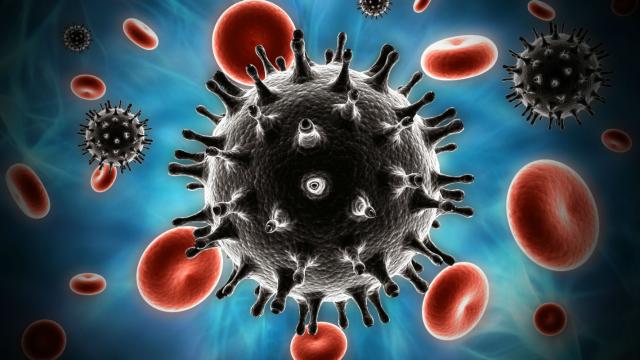The human immunodeficiency virus (HIV) is a crafty little bastard, constantly mutating to mask itself from our bodies’ defences but always entering cells through the same molecular door. The design of that cellular door is governed by our DNA, so why not change the lock by modding our genetic code?
In 2006, a minor medical miracle occurred. HIV-positive leukemia patient Timothy Ray Brown — the second Berlin Patient — received a bone marrow transplant that saved his life in more ways than one. The marrow that he received was from a donor with a unique double mutation to a gene on the third chromosome known as CCR5. This gene codes for the surface protein that the HIV virus uses to gain entry into our white blood cells (specifically, CD4+ T-cells); however the double mutation shuts down these sites and provides a natural immunity to HIV. This mutation is exceptionally rare, only occurring in about one per cent of caucasians and nowhere else. It’s been hypothesized that it’s this same natural immunity that allowed a small portion of Europeans to make it through the Black Plague unscathed.
While that was fantastic news for Brown, who nearly a decade later remains off of his retroviral drug regimen and maintains an undetectable level of the virus in his system, it’s not of much use to the rest of us. With both the mutation’s prevalence and bone marrow compatibility matches in general being so rare, there was no effective means of using transplants as delivery vectors for this beneficial genetic condition. And it’s worth noting that the very process of becoming HIV-free nearly killed Brown. But that’s where Professor Yuet Kan’s team at UCSF comes in.
Kan figured that if integrating this double mutation wouldn’t work on the macro level — that is, replacing a patient’s bone marrow with that of a naturally HIV-immune person’s — maybe it would at the molecular level, thereby allowing researchers to confer the benefits while cutting out the marrow donation. To that end, he and a team of researchers from the University of San Francisco are employing cutting-edge genetic editing techniques to snip out the beneficial length of DNA coding and integrate it with a patient’s own genomes.
The technique they’re using is known as CRISPR (Cas9) genome-editing. CRISPRs, (clustered regularly interspaced short palindromic repeats) are DNA delivery vectors that replace the existing base codes at a specific part of a specific chromosome with new base pair sets. Cas9, on the other hand are the “molecular scissors” that Kan’s team employs to first cut out the offending DNA. It sounds easy, sure — just find the string of DNA you want to replace, then snip it out with Cas9 DNA scissors, and install some new DNA using a CRISPR — however the nuts and bolts of the process are far more technically challenging.
The patient’s own blood cells would be employed as a precursor. Researchers would then have to convert those cells into induced pluripotent stem (iPS) cells by modulating a number of genetic switches, thereby instigating their regression to more basic stem cells. After that, the offending CCR5 gene would need to be knocked out and replaced with the better, double-mutated version before the now fortified blood cells were transfused back into the patient. Not only is there no chance of the body rejecting the new cells (they are the patient’s own after all), the technique also neatly sidesteps the whole embryonic stem cell issue.
While the technique is still in its early stages of development and no human trial dates have yet been set, it holds huge promise. Not just for the 35 million people annually infected by HIV, but also sufferers of sickle cell anemia and cystic fibrosis — two deadly diseases caused by a single protein deformation — could benefit from similar techniques. By figuring out which genes do what on our iPS cells, we could even theoretically grant everyone on Earth immediate immunity to any number of diseases.
Of course, being able to update and augment our genetic code opens up a whole slew of potential concerns, objections, and abuses. Just look at the ire raised over the use of embryonic stem cells in the early 2000s. People were lost their minds because they thought scientific progress was being built on the backs of fetuses. Researchers had to go and invent an entirely new way of making stem cells (the iPS lines) just to get around that one moralized sticking point, so you can bet there will be plenty of chimera, master race, and Island of Dr. Moreau references bandied about should we ever begin seriously discussing the prospect of upgrading our genes. And could certainly slow progress in this specific research.
That’s not to say that the hysteria that accompanies seemingly every news cycle these days is completely off base. Like cars, styrofoam, pressure cookers, and thermonuclear bombs, this technology can be used for evil just as easily as it can be for good. And while we’re not nearly as genetically complex as, say, an ear of corn, wrangling the myriad of interactions between our various genes is still an incredibly complex task and one with severe consequences should something go awry — even if we can avoid creating unwanted mutations through stringent testing and development methodology as we do with today’s pharmaceutical development. So why not turn ourselves into the ultimate GMOs? It certainly beats everyone becoming cyborgs. [Daily Beast – Daily Mail – Wiki 1, 2]
Picture: RAJ CREATIONZS
